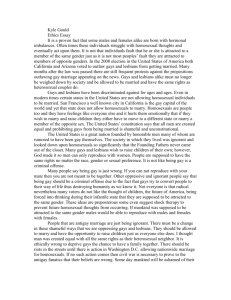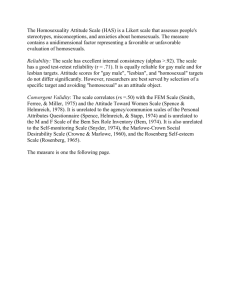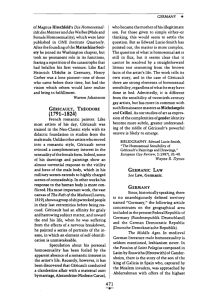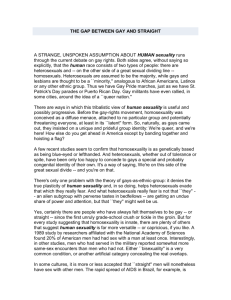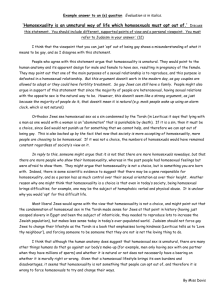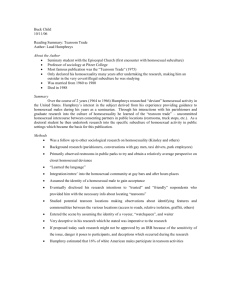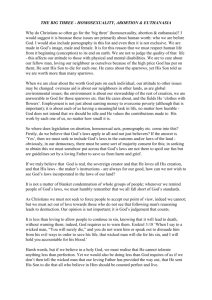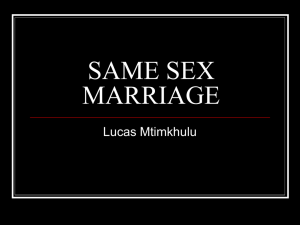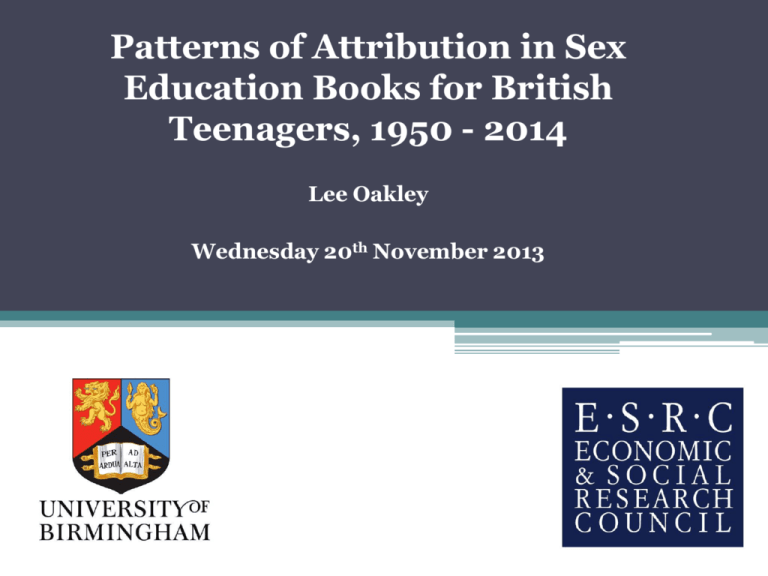
Patterns of Attribution in Sex
Education Books for British
Teenagers, 1950 - 2014
Lee Oakley
Wednesday 20th November 2013
Structure
• (1) Overview of the PhD
• (2) Overview of the presentation
• (3) Attribution in sex education books
• (4) Summary of findings (so far...)
(1) Overview of the PhD
(1) Overview of the PhD
Research Questions
(1) How are sexualities represented over time?
(2) How are social actors ((as) heterosexuals, lesbians,
gays, bisexuals, etc.) represented over time?
(3) How is the teenage reader positioned towards
various (i) sexualities and (ii) social actors over time?
(1) Overview of the PhD
Why start with the 1950s?
Practicalities
• (i) relatively few sex education books for
teenagers/young people exist before the 1950s;
• (ii) sexuality is hardly mentioned in these texts
before the 1950s
(1) Overview of the PhD
Data
81 sex education books (and counting...)
- the sexuality chapters / sections only
- taken from 1950 until the present
Currently c.94,000 words
(avg. text length = c. 1,100 words)
Previous Image
© Gladys D. Shultz (1957) It’s Time You Knew.
London: Darwen Finlayson.
Previous Image
© Colin Wilson (1966) Sex and the Intelligent
Teenager. London: Arrow Books.
Previous Image
© E.K. Morris (1971) Sex in a Young Man’s Life.
Surrey: Denholm House Press.
Previous Image
© Kaye Wellings (1986) First Love First Sex: A
Practical Guide to Relationships.
Wellingborough: Thorsons.
Previous Image
© Eleanor Stephens (1991) Love Talk: A young
person’s guide to sex, love and life. London:
Virago.
Previous Image
© Jacqui Bailey (2004) Sex, Puberty and All That
Stuff: A Guide to Growing Up. London: Franklin
Watts.
Previous Image
© Camilla de la Bedoyere (2010) Personal
Hygiene and Sexual Health. London: Evans
Brothers.
Attribution
‘...those formulations which disassociate the
proposition from the text’s internal authorial voice
by attributing it so [sic] some external source’
(Martin and White 2005: 111)
Attribution
Scientists have proven that the polar ice caps are melting.
[Endorsing]
Scientists say that the polar ice caps are melting.
[Acknowledging]
Scientists claim that the polar ice caps are melting.
[Distancing]
Attribution
Direct Reporting
I remember a boy who came to me and said, bluntly, ‘I am a homosexual’.
Pomeroy (1968) Boys and Sex
Indirect Reporting
Many people believe that God has allowed AIDS to appear to show his
hatred of sexual sin, particularly homosexual acts.
Day & Day (1987) Help! I’m Growing Up
(2) Overview of the Presentation
Semantic Sets
Educational & Academic Sources
The Reader
Family & Friends
Religious Sources
Historical Sources
Social Authorities
Medical & Scientific Sources
Social Sources
No Sources (Hearsay)
Teenagers
Political & Legal Sources
Other Sources
Gays, Lesbians, etc.
(2) Overview of the Presentation
4 Semantic Sets
1)
2)
3)
4)
Medical and Scientific Sources
Religious Sources
Social Sources
Gays, Lesbians, etc.
(3) Attribution in Sex Education Books
Medical and Scientific Sources
Medical and Scientific Sources
Young people have become infected with fear of homosexuality to such an extent
that, responsible educators and doctors tell us, many boys and girls worry about it
considerably.
Davis (1958) Sex and the Adolescent
It may be right to say that some of these are born with homosexual tendencies, but
the opinion is strongly held among psychiatrists that most instances are due to a
failure in upbringing, in the case of a boy something wrong in his mother's
relationship with him.
Barnes (1962) He and She
Medical and Scientific Sources
Some authorities stress masochism (sexual pleasure in being abused) as an
underlying cause of homosexuality. The entire personality structure of the
homosexual is seen as filled with an unconscious wish to suffer. Through
homosexual activity this wish is often fulfilled through arrest, imprisonment,
venereal diseases, beatings, and other problems which homosexuals
encounter.
Jones, Shainberg & Byer (1969) Sex
Medical and Scientific Sources
Psychiatrists believe that the unconscious reason why societies have made such
harsh laws against acts that harm no one is people's fear of their own unrecognised
perverse impulses, as well as the primitive but important need for society to breed.
Spock (1970) A Young Person’s Guide to Life and Love
Most psychiatrists feel that bisexuality is really a milder form of homosexuality.
Kaplan (1979) Making Sense of Sex
Medical and Scientific Sources
It is felt by Dr. Evelyn Hooker, an authority in this field, that the following
measures may help in preventing homosexuality....
Guttmacher (1971) Understanding Sex: A Young Person’s Guide
That homosexuality is a matter of degree and not a simple ‘black or white’
distinction, was emphasized by Kinsey and his co-workers...
Kenyon (1978) Sex
Medical and Scientific Sources
Anatomists have tried hard but unsuccessfully to prove that the pelvises of gay men
are different from those of straight men. Endocrinologists have equally
unsuccessfully tried to put homosexual behaviour down to hormones.
Wellings (1986) First Love, First Sex: A Practical Guide to Relationships
There is a new scientific theory which suggests that the homosexual gene can be
isolated. This indicates that gays are born and not made, and raises the huge moral
issue of science interfering with genetic balance.
Butterworth (1993) Straight Talk: How to Handle Sex
Medical and Scientific Sources
Many psychologists believe that everyone is bi-sexual, whether or not we
choose to do anything about it.
Goldman (1994) Sex. How? Why? What? The Teenager’s Guide
Some scientists believe that being homosexual or heterosexual is not
something you choose.
Harris (1994) Let’s Talk About Sex
Medical and Scientific Sources
This idea* originated with Sigmund Freud, who thought there was a
development in human beings from narcissism, or a preoccupation with self,
to homosexuality, to heterosexuality.
Pomeroy (1968) Boys and Sex
* = that homosexuality was a phase of adolescent sexual development (to be
grown out of in adulthood)
Medical and Scientific Sources
Writing in 1915, Sigmund Freud, the originator of psychoanalysis, who
stressed the importance of infantile sexuality in later development,
wrote: ‘From the point of view of psycho-analysis the exclusive sexual interest
felt by men for women is also a problem that needs elucidating.’So Freud was
pointing out that we need to know more not just about what causes
homosexuality, but also about what causes heterosexuality!
Stones (2001) Understanding Sex and Relationships
Medical and Scientific Sources
Summary of first (tentative) findings....
Medical and Scientific Sources
(Q1) How frequently are these sources quoted?
• Found in 18 out of the 81 texts (= 22%)
• 40 examples out of 426 total attributions (=9%)
• Tend to occur in clusters, particularly in the
following time periods:
(i) 1966 – 1971
(ii) 1986 - 1994
Medical and Scientific Sources
(Q2) Why are Medical & Scientific sources quoted?
1950 – c. early 1980s
• To explain the ‘causes’ of homosexuality / why
they exist
• To create + reinforce psychological profiles of
homosexuals (who they are, what they look like,
how they behave, etc.)
Medical and Scientific Sources
(Q2) Why are Medical & Scientific sources quoted?
c. mid 1980s – early 2000s
• To challenge heteronormative assumptions and
arguments about non-heterosexuality
• To account for why some people are ‘homosexual’
and others not
Medical and Scientific Sources
(Q2) Why are Medical & Scientific sources quoted?
early 2000s onwards
Medical & Scientific sources are no longer
mentioned.
Religious Sources
Religious Sources
Many important groups such as churches and civic organizations have,
without condoning homosexuality, pointed out that it is not per se physically
harmful, that confirmed homosexuals can have satisfactory social
relationships with one another, and with anyone else in all the non-sexual
aspects of their lives.
Bohannan (1970) Love, Sex and Being Human
Religious Sources
God says in Leviticus 20 verse 13: ‘If a man has sexual relations with another
man, they have done a disgusting thing, and both shall be put to death.’
Thankfully, God doesn't demand the same punishment for a homosexual
today! But that verse shows just how wrong homosexual sin is.
Day and Day (1987) Help! I’m Growing Up!
Homosexual sin is wrong because God says it
’s wrong.
Day and Day (1987) Help! I’m Growing Up!
Religious Sources
Many people believe that God has allowed AIDS to appear to show his hatred
of sexual sin, particularly homosexual acts.
Day and Day (1987) Help! I’m Growing Up!
Religious Sources
The Bible makes it quite clear that although it is not wrong to have homosexual
feelings, it is wrong, and against the way we have been made, to indulge in
homosexual behaviour.
Lawson and Skipp (1985) Sex and That: What’s it all about?
In other words, Paul describes an act of homosexual intercourse, and says, ‘That
does not happen in God’’s kingdom. You cannot go to bed with a same-sex partner,
whether or not you love them, and claim to be acting under Jesus
’ lordship.
Pierson (1992) Sex and You
Religious Sources
‘Celibacy is a singular source of spiritual fertility in the world’ Pope John Paul
II (1992).
Fisher (1994) Your Pocket Guide to Sex
On the other hand, Europeans, most of whom were of Catholic or Protestant
descent, built a Christian society that viewed homosexuality as a sin.
Pavanel (2003) The Sex Book
Religious Sources
Summary of first (tentative) findings....
Religious Sources
(Q1) How frequently are these sources quoted?
• Found in 13 out of the 81 texts (= 16%)
• 47 examples out of 426 total attributions (=11%)
• Tend to occur in clusters, particularly in the
following time periods:
(i) 1985 – 1992
(ii) 2002-2004
Religious Sources
(Q2) Why are Religious sources quoted?
Late 1960s – early 1990s
• To outline Christian views on nonheterosexuality (which the authors endorse).
• To condemn and question the acceptability of
non-heterosexuality.
Religious Sources
(Q2) Why are Religious sources quoted?
early – mid 2000s
• To outline Christian views on nonheterosexuality (which the authors acknowledge
or distance themselves from)
No further religious sources after 2004.
Social Sources
Social Sources
It is always thought that male homosexuals want to corrupt boys. In general,
this is not true as a homosexual seeks for someone who has strong masculine
attributes and on whom he can depend.
Bevan (1966) Sex: The Plain Facts
A common misconception one frequently hears is that ‘some boys are born
queer’.
Pomeroy (1968) Boys and Sex
Social Sources
Another popular belief is that homosexuals have different kinds of glands or
bodies. Studies have shown that this is not the case, however.
Pomeroy (1968) Boys and Sex
Some people think male homosexuals have special glands in their throats
which make them want oral contact with a man’s penis.
Pomeroy (1968) Boys and Sex
Social Sources
Another common misconception is that in a lesbian relationship one partner
exclusively plays the male role and is called a ‘butch’, while the other
exclusively plays the ‘femme’.
Pomeroy (1969) Girls and Sex
The widespread idea that a homosexual can be identified in adolescence is not
only untrue. It actually tends to increase the number of permanent adult
homosexuals.
Hettlinger (1970) Growing Up with Sex
Social Sources
There are groundless fears that children or youths seduced by adult
homosexuals will be permanently affected.
Guttmacher (1971) Understanding Sex: A Young Person’s Guide
Ignore the stupid people who suggest that being friends with gay men or
lesbian women can make you gay.
Naik (1998) Sex
Social Sources
Summary of first (tentative) findings....
Social Sources
The attribution of Common Misconceptions is useful for
revealing what wider social attitudes are prevalent at a
given point in time.
The commonest attributed misconceptions are based on
what causes, or constitutes, homosexuality.
Common Misconceptions tend to be attributed to society
as a whole, rather than specific groups or individuals.
Social Sources
Attributions to
Social Sources
(Q1) How frequently are these sources quoted?
• Found in 53 out of the 81 texts (= 65%)
• 137 examples out of 426 total attributions
(=32%)
• One of the few semantic sets to occur
consistently throughout the time scale 19502014.
Social Sources
(Q2) Why are social sources quoted?
1950 – mid 2000’s
• To outline urban myths about gays, lesbians and
bisexuals (which are usually acknowledged or
distanced)
• To outline the (usually) negative views held by
particular sections of society towards nonheterosexuality.
Gays, Lesbians, etc.
Gays, Lesbians, etc.
Some of the greatest men in history have been homosexual though we must be
on our guard in this matter as homosexuals notoriously claim all sorts of
people on very flimsy evidence. Thus homosexuals have claimed Jesus as one
of them, because the Gospels talk of St John as
’the disciple whom Jesus
loved’’. Leonardo da Vinci, Michelangelo, Shakespeare, and many other artists
are claimed...
James (1969) The Facts of Sex
Gays, Lesbians, etc.
Then consider the question of how much homosexual experience someone
must have before he is ‘homosexual’. For example, I recall a man who reported
that he had more than 10,000 homosexual partners (he kept a careful count)...
Pomeroy (1968) Boys and Sex
Individual male homosexuals have reported sexual contact with as many as
1000 different partners per year.
Jones, Shainberg & Byer (1969) Sex
Gays, Lesbians, etc.
One leading apologist for the homosexual community has said, very frankly, that
where homosexuals establish permanent love relationships (as some undoubtedly
do) they are usually not also physical or genital.
Hettlinger (1970) Growing Up with Sex
Homosexual groups who are continuing to work, quite properly, for an end to all
such unfair discrimination, nevertheless strongly urge young people to avoid a way
of life that frequently leads to embarrassment, shame and humiliation.
Hettlinger (1970) Growing Up with Sex
Gays, Lesbians, etc.
When one large sample of homosexuals was asked,
’If you had a son would
you want him to be a homosexual?
’ only two out of every hundred
answered
’Yes’
.
Hettlinger (1970) Growing Up with Sex
Gays, Lesbians, etc.
No father in England would wish his son to be homosexual, but not because it
is wicked or even distasteful, but for the same reason that he might regret his
son marrying a Negro woman, not because of race or colour but because it
would make life in the society in which he has to live more complicated.
James (1969) The Facts of Sex
Gays, Lesbians, etc.
‘I decided to tell my mother after a lot of thought. She was always saying,
what's wrong, why do you look so sad? In the end I told her. She was terribly
shocked, but after a few minutes she just put her arms around me and said,
I’ll
never stop loving you whatever you call yourself.”My dad wasn't so
understanding, though. He won't speak to me.
’ (Nikki)
Butterworth (1993) Straight Talk: How to Handle Sex
Gays, Lesbians, etc.
‘I must have been 15 or 16 when I first realized I was gay. I came out at 17 –
first, to my mother, who didn't mind: in fact, she said it was no surprise to her.
It took a bit longer with my father; I was just talking to him, and mentioned
some male relationships, and he had kind of accepted it by then: he said he'd
gathered I was gay.’
Wright (1998) Sex
Gays, Lesbians, etc.
Gay rights groups claim that this Section is wide open to misinterpretation
and abuse and will encourage discrimination against homosexuals themselves.
Grist (1990) Sex and Sexuality
Many teenage gays, bisexuals and lesbians say that they felt different from
quite an early age.
Pollard & Kent (2004) Sex
Gays, Lesbians, etc.
’I've been celibate for 14 years... I wouldn't wish my great wobbly body on top
of anybody else's.
’ Stephen Fry.
Fisher (1994) Your Pocket Guide to Sex
’There's this illusion that homosexuals have sex and heterosexuals fall in love.
That's completely untrue. Everybody wants to be loved.’’Boy George.
Fisher (1994) Your Pocket Guide to Sex
Gays, Lesbians, etc.
Summary of first (tentative) findings....
Gays, Lesbians, etc.
(Q1) How frequently are these sources quoted?
• Found in 47 out of the 81 texts (= 58%)
• 124 examples out of 426 total attributions
(=29%)
• There seems to be two main clusters:
(i) mid 1960’s – mid 1980’s
(ii) late 1980’s – late 2000’s
Gays, Lesbians, etc.
(Q2) Why are Gays, Lesbians, etc. quoted?
1950 – mid 1980’s
• Negative representations by gay spokespeople or
groups of other homosexuals
• Representations of gays, lesbians & bisexuals as
sexually promiscuous and predatory
Gays, Lesbians, etc.
(Q2) Why are Gays, Lesbians, etc. quoted?
late 1980’s onwards
• Individual gay and lesbian teenagers are given a
voice, usually in the form of mini anecdotes such as
‘coming out’ narratives.
• Prominent gay people (e.g. Stephen Fry, Boy George)
are given voices. Interestingly, their quotes are not
necessarily restricted to the topic of sexuality.
(4) Summary of findings (so far...)
(4) Summary of findings (so far...)
Attribution is used to perform a wide range of
functions.
- to devolve responsibility for labels (e.g. ‘queer’,
‘poof’, ‘dyke’ and other pejorative labels)
- to advance (usually extreme) views which the
author would not feel comfortable averring
outright
(4) Summary of findings (so far...)
- to outline old beliefs which are no longer
acceptable and/or the author does not agree
with
- to give a voice to the subjects under discussion
(i.e. teenagers): e.g. through narratives
- to reinforce the author’s own argument
(4) Summary of findings (so far...)
Most common attribution (overall) is to the
semantic set of Social Sources.
Pre c.mid 1980s – attributions are dominated by
Medical and Scientific Sources, Social Sources,
and Historical Sources semantic sets.
(4) Summary of findings (so far...)
After c.mid 1980s – attributions are dominated by
Gays, Lesbians, etc., Social Sources, and Family &
Friends semantic sets.
The most marked contrast over time is in the
Gays, Lesbians, etc. semantic set.
Thank You
Contact:
LJO848@bham.ac.uk
http://bham.academia.edu/LeeOakley

